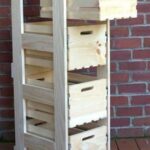What is the woodwork covering windows in Tunis called? The intricate and beautiful woodwork found adorning windows in Tunis is a significant element of the city’s rich architectural heritage. Tunisian architecture is characterized by its unique blend of Islamic, Arab, and Mediterranean influences, and the use of woodwork is a testament to the craftsmanship and artistry that has been passed down through generations.
The importance of woodwork in Tunisian culture cannot be understated, as it not only serves a functional purpose but also holds deep cultural and historical significance. From traditional homes to historical landmarks, wooden window coverings are an integral part of Tunisia’s architectural identity.
In this article, we will delve into the history of woodwork in Tunisian architecture, explore the different types of woodwork covering windows in Tunis and their significance, discuss the artistry and craftsmanship involved, and examine the materials used in creating these intricate designs.
Additionally, we will look at how preservation efforts and modernization have impacted woodwork in Tunisian architecture, as well as highlight must-visit locations where one can appreciate the timeless elegance and cultural significance of these wooden window coverings.
The Importance of Woodwork in Tunisian Culture and Architecture
Woodwork has always played a significant role in Tunisian culture and architecture, adding to the beauty and uniqueness of the buildings in this North African country. The intricate designs and craftsmanship of woodwork covering windows in Tunis are not only aesthetically pleasing but also hold cultural and historical significance.
The woodwork covering windows in Tunis is known as “Moucharabieh” or “Mashrabiya,” which is an integral part of Tunisian architectural heritage. The Moucharabieh is a type of latticework that is often made from cedar wood and intricately carved to create stunning geometric patterns. These wooden screens serve both practical and symbolic purposes, providing privacy for inhabitants while allowing ventilation and natural light to enter the building.
The Moucharabieh has been used in Tunisian architecture for centuries, with its origins dating back to the Islamic period. Its design reflects the influence of various cultures that have shaped Tunisia’s history, including Arab, Turkish, and Andalusian influences. The use of woodwork in Tunisian architecture also symbolizes the importance of craftsmanship and traditional skills passed down through generations.
History of Woodwork in Tunisian Architecture
Tunisian architecture is known for its stunning traditional woodwork, which adds both beauty and functionality to the design of buildings. The use of intricate woodwork covering windows in Tunis has a long and fascinating history that dates back centuries. This section will delve into the historical significance of woodwork in Tunisian architecture, shedding light on how it has shaped the architectural landscape of the region.
Woodwork has been an integral part of Tunisian architecture for hundreds of years, with its origins tracing back to the influence of various civilizations such as the Arabs, Andalusians, Ottomans, and French. Each of these cultures has left its mark on Tunisian architecture, contributing to the rich diversity and unique blend of styles seen in the woodwork covering windows in Tunis today.
The intricate carvings and geometric patterns found in traditional woodwork are a testament to the skilled craftsmanship and artistic expertise that has been passed down through generations.
Tunisian woodwork not only serves a decorative purpose but also plays a functional role in providing privacy and protection from the harsh sun while allowing ventilation. This combination of form and function is a hallmark of Tunisian architecture and reflects the deep connection between culture, tradition, and practicality. Understanding the history of traditional woodwork in Tunisian architecture provides valuable insight into the cultural heritage and timeless elegance that continues to shape the architectural identity of Tunisia.
| Woodwork Style | Historical Influences |
|---|---|
| Moucharabieh | Arab and Andalusian influences |
| Gazelle Horns | Ottoman influence |
| Saf Saf (Traditional Lattice Work) | Berber influence |
Types of Woodwork Covering Windows in Tunis and Their Significance
Mashrabiyas: A Symbol of Privacy and Elegance
One of the most iconic types of woodwork covering windows in Tunis is the mashrabiya. These latticed screens are not only visually stunning but also serve a practical purpose. The intricate design allows for ventilation and the passage of air, while still maintaining privacy for the residents within. This traditional element of Tunisian architecture adds an air of elegance to buildings, with its geometric patterns and delicate craftsmanship.
Balcony Railings: Combining Functionality and Beauty
In addition to mashrabiyas, another form of woodwork covering windows in Tunis can be seen in the elaborate balcony railings. These wooden adornments not only provide safety for those leaning against them but also contribute to the overall aesthetics of the building. The detailed carvings and designs showcase the talent and creativity of Tunisian artisans, making these structures stand out as works of art in their own right.
Shutters: A Blend of Practicality and Tradition
Wooden shutters are another common feature in Tunisian architecture, serving both a functional and decorative purpose. These window coverings not only protect against harsh sunlight and inclement weather but also add a touch of traditional charm to the exterior of buildings. The intricate carvings on these shutters highlight the attention to detail that is characteristic of Tunisian woodwork, showcasing the country’s rich artistic heritage.
The different types of woodwork covering windows in Tunis all contribute to the unique charm and beauty of Tunisian architecture. From mashrabiyas to balcony railings to shutters, each element showcases the careful craftsmanship and cultural significance that make these structures truly remarkable pieces of artistry.
The Artistry and Craftsmanship of Woodwork in Tunisian Architecture
Traditional Techniques and Designs
The woodwork covering windows in Tunis features traditional techniques and designs that have been passed down through generations. These exquisite carvings often include geometric patterns, floral motifs, and calligraphy, reflecting the influence of Islamic art and architecture. Each piece of woodwork is carefully handcrafted, showcasing the precision and expertise of Tunisian artisans.
Symbolism and Meaning
In addition to their aesthetic appeal, the woodwork covering windows in Tunis also carry symbolic meaning. Certain designs may hold religious significance or represent aspects of nature, history, or folklore. For example, some patterns may evoke the image of an olive tree, symbolizing peace, prosperity, and resilience – all values deeply rooted in Tunisian culture.
Legacy of Master Artisans
The legacy of master artisans who specialize in creating woodwork for windows in Tunis continues to thrive today. These highly skilled craftsmen dedicate themselves to preserving the authenticity of traditional designs while also incorporating contemporary elements to ensure that this cherished art form remains relevant in modern architecture. Their passion for their craft is evident in every meticulously crafted piece of woodwork, reinforcing its status as an integral part of Tunisian architectural heritage.
Materials Used in Creating Woodwork for Windows in Tunis
Woodwork covering windows in Tunis is a significant part of the traditional architecture and cultural heritage of the city. The materials used in creating woodwork for windows play a vital role in not only the aesthetic appeal but also the durability and sustainability of the structures. In Tunisian architecture, the most commonly used material for woodwork is cedar, known for its strength, resistance to decay, and beautiful natural color.
Cedar woodwork covering windows in Tunis is intricately carved and designed, showcasing the skill and artistry of local craftsmen. The use of cedar reflects the importance of this material in Tunisian culture and its availability in the region. Another popular material for creating woodwork for windows is olive wood, which adds a unique texture and rich tone to the architectural elements.
In addition to cedar and olive wood, other materials such as wrought iron are often incorporated into woodwork designs to add decorative details and structural support. This combination of materials adds depth and visual interest to window coverings while also serving functional purposes. Overall, the careful selection of materials used in creating woodwork for windows in Tunis contributes to the timeless elegance and cultural significance of these architectural features.
Preservation and Modernization of Woodwork in Tunisian Architecture
Woodwork covering windows in Tunis, known as “Moucharabieh,” has been an essential element of Tunisian architecture for centuries. This delicate latticework not only provides shade and privacy but also serves as a stunning ornamental feature that adds to the aesthetic appeal of traditional Tunisian buildings. As modernization continues to shape the architectural landscape, there is a growing effort to preserve and adapt this iconic woodwork to contemporary designs while maintaining its cultural significance.
Efforts to preserve traditional woodwork in Tunisian architecture involve both conservation techniques and adaptation strategies. Preservation initiatives aim to safeguard existing Moucharabieh from deterioration due to environmental factors and neglect. At the same time, modernization seeks to integrate woodwork into new construction projects, blending traditional craftsmanship with innovative design concepts.
The modernization of woodwork in Tunisian architecture involves collaborations between architects, designers, woodworkers, and preservation experts. By combining ancient techniques with modern materials and technology, these professionals strive to create functional and visually striking window coverings that honor the legacy of Moucharabieh while meeting the demands of contemporary buildings.
Restoring historical sites featuring these exquisite window treatments provides visitors with a glimpse into Tunisia’s rich architectural heritage and demonstrates the enduring relevance of woodwork in the country’s built environment.
| Woodwork Preservation Strategies | Modernization Approaches |
|---|---|
| Conservation techniques such as regular maintenance, protective coatings, and structural support | Collaborations between architects, designers, woodworkers, and preservation experts |
| Safeguarding existing Moucharabieh from environmental factors and neglect | Integrating traditional craftsmanship with innovative design concepts |
| Restoration of historical sites featuring exquisite window treatments | Using modern materials and technology to create functional yet visually striking window coverings |
Where to See and Appreciate the Woodwork Covering Windows in Tunis
When visiting Tunis, there are several must-visit locations and landmarks where you can see and appreciate the beautiful woodwork covering windows. Here are some of the most iconic places to admire this traditional Tunisian architecture:
- The Medina of Tunis: This UNESCO World Heritage site is a treasure trove of stunning woodwork adorning windows, balconies, and doors. Take a stroll through the narrow alleyways of the medina to witness the timeless elegance of this craftsmanship.
- The Bardo Museum: Located in a former Beylical palace, the Bardo Museum is home to an extensive collection of Tunisian art and artifacts, including intricately carved woodwork from different periods in history.
- Dar Othman: This beautifully restored historic house in the medina showcases exquisite examples of woodwork covering windows, providing visitors with a glimpse into traditional Tunisian design and architecture.
- The Great Mosque of Zitouna: As one of the oldest mosques in the city, the Great Mosque features elaborate woodwork decorating its windows and doors, offering an insight into the architectural significance of this art form within Islamic traditions.
These locations not only allow you to admire the craftsmanship of woodwork covering windows in Tunis but also provide a deeper understanding of its cultural significance within Tunisian architecture. Whether you’re exploring historic homes or visiting museums, experiencing these artistic expressions firsthand is an essential part of appreciating Tunisian heritage.
Conclusion
In conclusion, the woodwork covering windows in Tunis holds a timeless elegance and significant cultural importance within Tunisian architecture. The intricate designs and craftsmanship of this woodwork reflect the rich history and traditions of Tunisia, adding to the beauty of the country’s architectural landscape. From traditional homes to historical landmarks, the woodwork covering windows in Tunis serves as a visual representation of the skill and artistry of Tunisian craftsmen.
The preservation and modernization of woodwork in Tunisian architecture are crucial in maintaining its cultural significance while adapting to modern needs and styles. Efforts to conserve and restore historic woodwork, as well as incorporating it into contemporary architectural designs, ensure that this cherished tradition continues to thrive for future generations to appreciate and admire.
For those interested in experiencing the beauty of woodwork covering windows in Tunis firsthand, there are several must-visit locations and landmarks throughout the city where one can fully appreciate the artistry and craftsmanship involved. Whether exploring Medina’s narrow streets lined with ornate wooden screens or visiting palaces showcasing elaborate woodwork details, there are numerous opportunities to witness the magnificence of Tunisian architecture.
These sites offer a glimpse into the enduring legacy of woodwork covering windows in Tunis, providing visitors with a deeper understanding of its cultural significance and timeless elegance.
Frequently Asked Questions
What Is a Mashrabiya Screen?
A mashrabiya screen is a type of traditional architectural element commonly found in the Middle East, particularly in Egypt and the Levant region. It is typically made of carved wood or intricate latticework, and is used to provide privacy, regulate sunlight, and promote airflow within a building.
What Is a Mashrabiya Design?
Mashrabiya design refers to the ornate patterns and intricate geometric shapes that are commonly found in mashrabiya screens and other architectural elements. These designs often feature precise and detailed craftsmanship, creating a visually stunning effect when light passes through them.
What Is the Mashrabiya Technique?
The mashrabiya technique involves the skilled art of crafting intricate wooden screens using traditional woodworking methods. This often includes carving, fretwork, and latticework to create beautifully detailed patterns within the wooden panels. The technique requires a high level of precision and craftsmanship to achieve the desired aesthetic and functional qualities of a mashrabiya screen.

Hi everyone! I’m a woodworker and blogger, and this is my woodworking blog. In my blog, I share tips and tricks for woodworkers of all skill levels, as well as project ideas that you can try yourself.





